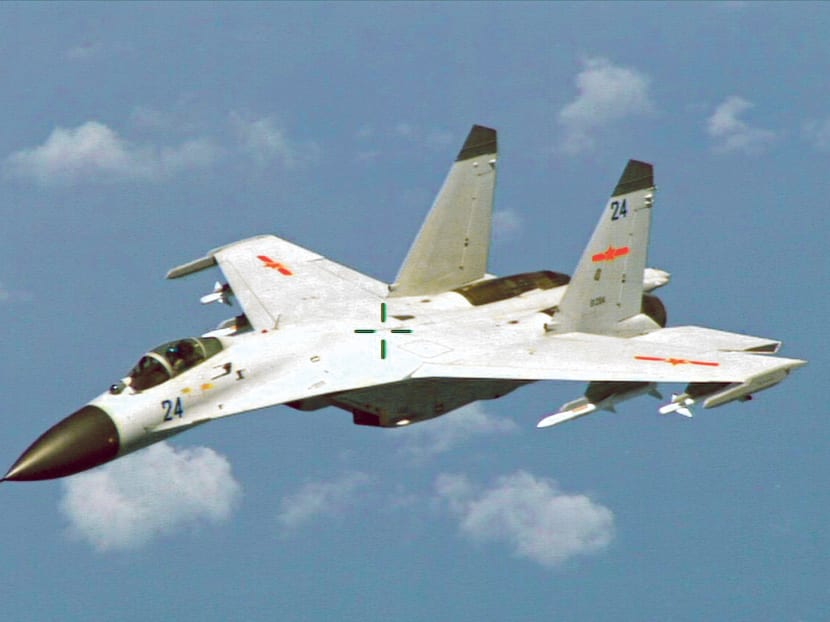US air force chief cautious about risky Chinese intercepts
HONG KONG — The United States is concerned Chinese jets may engage in further risky intercepts of its military aircraft, even after starting talks aimed at avoiding such encounters, the new commander of the US air force in the Pacific said.

A Chinese fighter jet flying near a US P-8 Poseidon east of Hainan Island in August. The Pentagon has described the incident as unsafe and unprofessional. Photo: Reuters
HONG KONG — The United States is concerned Chinese jets may engage in further risky intercepts of its military aircraft, even after starting talks aimed at avoiding such encounters, the new commander of the US air force in the Pacific said.
A Chinese fighter jet flew within about 6m of a US P-8 Poseidon aircraft flying at more than 644kmh near Hainan Island, China’s gateway to contested territory in the South China Sea, on Aug 19, an encounter the Pentagon described as unsafe and unprofessional.
“I never say never,” General Lori Robinson, 55, said when asked whether talks meant such behaviour would cease. “What’s important is we start the dialogue and that we come to an understanding of what a traditional intercept is.”
Gen Robinson replaced Gen Herbert “Hawk” Carlisle as commander of the US Pacific Air Forces (PACAF) on Oct 16. Though she has no specific meetings scheduled, she said she hopes to discuss air safety when she meets Chinese military personnel at the Zhuhai airshow in Guangdong and a training conference this month.
The aim is for China to agree to abide by intercept procedures outlined by global standards, she said.
The air force has no plans to change how it conducts its missions in the region, said Gen Robinson, who has clocked more than 900 flying hours and was promoted to the rank of four-star general when she replaced Gen Carlisle. Gen Robinson, who joined the air force in 1982, is the first woman to have an air-force command. She was previously vice-commander of the air combat command at Langley Air Force Base in Virginia.
The core of the US-China air dispute is what activities are permitted within a country’s 322km offshore exclusive economic zone, where coastal states have sovereign rights over marine resources. America says international law permits such flights, which have been a standard practice for decades. China objects, saying such freedom is reserved for civilian jets.
Asked whether she thought the August incident occurred because of a “rogue” Chinese pilot or was an officially backed action, Gen Robinson said: “We encourage safe and acceptable flight practices throughout the region.” The general, who is responsible for air-force operations for more than half the globe, with oversight of 46,000 personnel, spoke in a phone interview from Pearl Harbour, Hawaii.
Gen Carlisle met Chinese General Huang Guoxian on Sept 23 to start safe-flying discussions, said Captain Susan Harrington of the PACAF’s public affairs bureau. They talked about safe and non-traditional intercepts, Gen Robinson said. The air force will continue its missions regardless of any air defence identification zones (ADIZs) declared by China, she added.
Last November, Beijing announced an ADIZ over the East China Sea that includes islands it and Japan claim as territory and demanded civil and military aircraft present flight plans before entering the space. Two US unarmed B-52 bombers flew through the zone after it had been declared.
“ADIZs are not prohibited in international law, nor are they specifically addressed at international conventions,” Gen Robinson said. “So, we will continue to professionally conduct operations in international airspace and the US air force in the Pacific will not change how we conduct those missions in the region, all in accordance with international law.”
This would apply should Beijing declare an ADIZ over the South China Sea, she said. China claims about 90 per cent of the area and has disputes with countries such as Vietnam. About half of the world’s merchant tonnage flows through the waters, carrying about US$5.3 trillion (S$6.8 trillion) of goods a year.
China dragged an oil rig into waters claimed by Vietnam in May and has completed an upgraded airstrip in the contested Paracel Islands. It also has an artificial island project in the Spratly Islands, parts of which are claimed by the Philippines. Its actions to back its territorial claims are sometimes seen as an effort to change the balance of power in Asia, where the US has had almost unfettered air and sea access for half a century.
“China is a country that is interested in continuing to be part of the region and I think it looks at the US as part of the region,” Gen Robinson said, adding that the air force’s presence and standing in the region had not changed since President Barack Obama announced America’s “pivot to Asia” policy in 2011. US crew operate 360 aircraft, a PACAF video shows.
“From a Pacific air-force perspective, we’ve always been in the region and our presence just continues to be in the region,” Gen Robinson said. For the air force, the pivot means building on partnerships and military-to-military relationships, she added.
Gen Robinson said a priority of her command would be fostering military-to-military engagement with Asian nations, including China. BLOOMBERG






